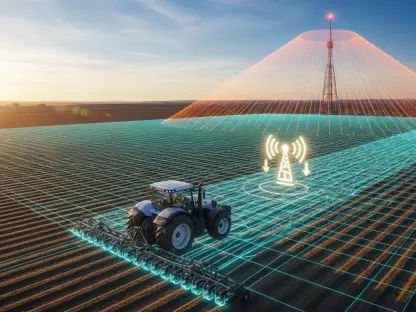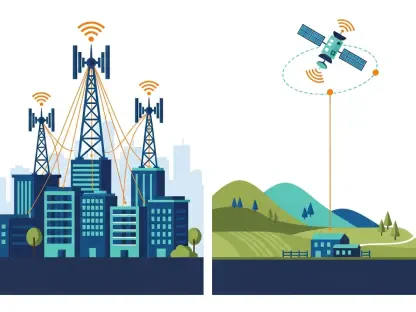In a groundbreaking endeavor, a team of researchers at Virginia Tech is spearheading a transformative approach to wireless networks, focusing on the integration of artificial general intelligence (AGI) to make these systems function more like human cognition. Led by Dr. Walid Saad, Ph.D. student Omar Hashash, and postdoctoral researcher Christo Thomas, this pioneering project envisions AGI-native networks capable of understanding context, solving novel problems, and adapting without requiring reprogramming. This ambitious initiative has the potential to revolutionize how wireless networks operate, pushing the boundaries of current technology.
Converging Advanced AI with Wireless Technology
The Emergence of AGI-native Networks
AGI-native networks represent a significant departure from existing AI systems, which are primarily designed for pre-programmed, task-specific functions. Unlike these conventional systems, AGI-native networks are engineered to handle complex scenarios, recognize surrounding events, and adjust their operations autonomously, mimicking a form of common sense. The architecture proposed by Saad and his team includes three main components: perception, which involves the system collecting and interpreting data; a world model, helping the network develop a digital understanding of its environment; and planning, where decisions are made based on the acquired knowledge and objectives.
An innovative aspect of this system is the utilization of digital twins—virtual replicas of real-world environments such as hospitals or transportation systems. These digital twins enable simulations of various scenarios, significantly enhancing the network’s ability to manage resources and optimize operational efficiency. This approach allows for the creation of highly adaptable and intelligent networks that can anticipate and respond to dynamic situations in real-time.
Integrating Real and Virtual Worlds
This convergence of advanced AI with wireless technology signifies a shift from traditional data transmission to an all-encompassing approach that addresses dimensions like time, space, and user behavior. According to Saad, the synthesis of real and virtual worlds necessitates AI capabilities beyond what current technologies offer. These networks, therefore, need to evolve to understand and interact with their environments in more nuanced and sophisticated ways.
Hashash underscores the importance of designing future wireless networks with an inherent capacity to learn and reason, rather than simply incorporating existing AI tools. While the realization of fully intelligent wireless networks may still take several years, the foundational elements proposed by this team can begin to be implemented immediately. This move sets the stage for a smarter, more interconnected future, paving the way for systems that can learn and interact much like human beings.
Digital Twins and Beyond
Enhancing Resource Management
Digital twins are vital to the successful implementation of AGI-native networks, providing a virtual environment where different scenarios can be tested. By simulating real-world conditions, these digital replicas enable the network to predict and plan for various outcomes, thus improving resource management and decision-making processes. For instance, in a hospital setting, a digital twin can simulate patient inflows, staff availability, and emergency scenarios to optimize space usage, reduce waiting times, and improve overall service quality.
The application of digital twins in transportation systems is equally promising. They can model traffic patterns, predict congestion, and devise efficient routing strategies to enhance the flow of vehicles and public transportation. The ability to simulate different conditions and outcomes in a controlled, virtual environment reduces the risks and costs associated with real-world testing, resulting in more robust and reliable networks.
Optimizing Operational Efficiency
The use of digital twins extends beyond resource management to enhance the operational efficiency of AGI-native networks. By continuously monitoring and analyzing data from the virtual environment, these networks can identify potential issues and optimize their performance proactively. This capability is critical in ensuring that the networks remain resilient and responsive to changing conditions, minimizing downtime and maintaining high standards of service.
Furthermore, the integration of AGI with digital twins facilitates continuous learning and adaptation. As the network interacts with its environment and processes new information, it refines its world model and improves its decision-making abilities. This iterative process mirrors human learning, where experiences shape understanding and behavior over time. The result is a highly adaptable network capable of evolving to meet new challenges and opportunities.
Future Prospects of AGI-native Networks
Towards Human-Like Interaction
The vision for AGI-native networks extends beyond technical enhancements to encompass a fundamental shift in how these systems interact with users. By incorporating elements of common sense and contextual understanding, these networks can provide more intuitive and natural interactions. This advancement has significant implications for user experience, as the network can anticipate user needs, offer personalized services, and adapt to individual preferences seamlessly.
Moreover, the development of AGI-native networks paves the way for new applications and services that were previously unimaginable. From smart cities to automated healthcare systems, the potential uses of these intelligent networks are vast and varied. As the technology continues to evolve, it will open up new possibilities for innovation and growth across multiple industries.
Implementing the Vision
Although the realization of fully intelligent wireless networks may be years away, the foundational work conducted at Virginia Tech represents a crucial first step in this journey. The principles and technologies proposed by Saad and his team provide a roadmap for future developments, offering a clear vision of what AGI-native networks can achieve. By starting the implementation of these foundational elements now, the path towards smarter, more connected networks is already being paved.
This innovative vision promises to significantly alter the landscape of wireless networks, moving towards systems that replicate human learning and interaction capabilities. In doing so, it not only enhances the functionality and efficiency of these networks but also brings a new dimension to their role in our lives.
Reimagining the Future of Wireless Networks
At Virginia Tech, a groundbreaking team led by Dr. Walid Saad, Ph.D. student Omar Hashash, and postdoctoral researcher Christo Thomas is revolutionizing wireless networks. They’re pioneering a transformative approach by integrating artificial general intelligence (AGI) to make these systems function similar to human cognition. This innovative project proposes AGI-native networks that can grasp context, tackle unique problems, and adapt autonomously without needing reprogramming. Their ambitious effort has the potential to significantly enhance the efficiency and flexibility of wireless networks, pushing the boundaries of current technology. As these networks evolve, they aim to become more responsive and intuitive, operating in ways previously thought to be exclusive to human intelligence. This breakthrough could signal a major shift in how wireless communication systems are designed and implemented in the future, offering a glimpse into a new age of intelligent technology-driven connectivity.









